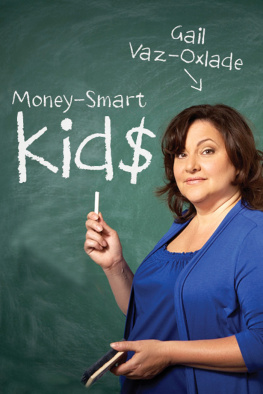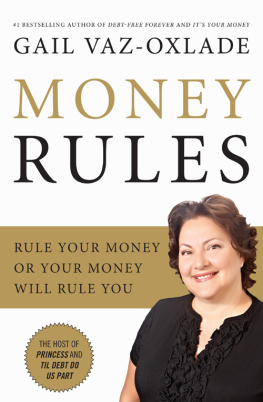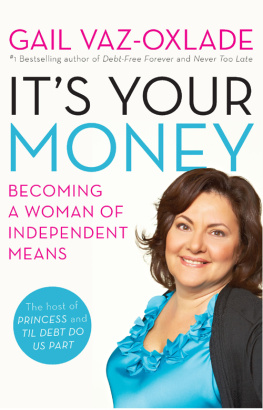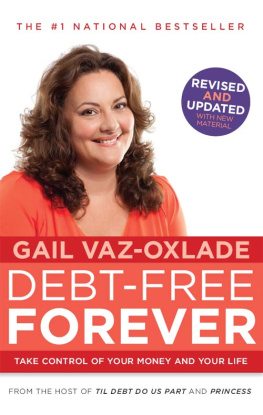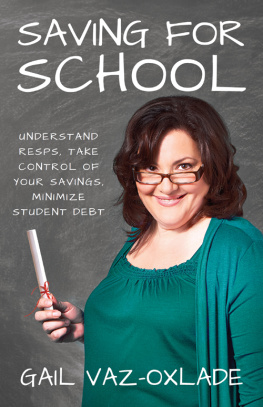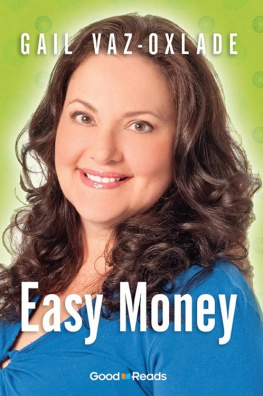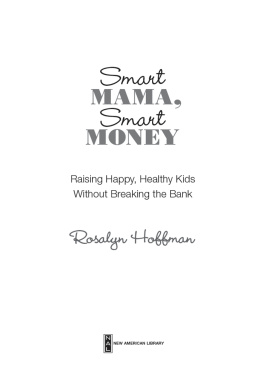To my beautiful children, Alexandra and Malcolm, who have taught me all I know about mommyhood. It has been a privilege to be your teacher and your guide. I love you two bits!
Contents
Everyone thinks kids should learn about money: how it works and how to manage it. But everyone also seems to think its someone elses job to teach kids about money. Money lessons should be taught at school. Borrowing should be taught by lenders. Banking should be taught by, well, bankers.
The best place for kids to learn about how money worksand the role it should play in their livesis at home. While financial literacy is a hot topic, there have been times when other hot topics took the front burner. Remember the food pyramid? Its still being taught at school, which is why we no longer have a child-obesity problem. Oh, wait... thats not right!
When kids are introduced to the food pyramid at school, they learn all about which foods are healthiest, and how much of each kind of food they should include in their diets. But telling kids to eat five to seven servings of fruits and veggies each day has little impact if, when they get home, mommy and daddy serve up a hot dog, a bag of chips, and a tin of pop for dinner. Out the window goes the lesson just learned and kids come to know that the stuff theyre taught at school is irrelevant to their lives.
And so it is with money. We can talk until were blue in the face about how important it is to save, but if our children dont see us saving at home, they wont learn the lesson. We can talk about becoming smart consumers, but if parents whip out their credit cards every time something takes their fancyor worse, because a kid demands ittheyre teaching kids they dont have to prioritize; they can buy whatever they want whenever they want it, as long as they have enough credit.
But growing up in a financially sound home doesnt automatically translate into financial success for kids. Children dont learn about money by osmosis. They need to be taught the rules of good money management. They need lots of practice to incorporate those lessons into their lives. They need to be able to fail safely and adjust their thinking as they learn about how money works. And theres a lot to learn. So we should start early.
Want to teach your children to be more financially successful? Want them to avoid living from paycheque to paycheque? Want them to steer clear of crippling student loans and credit card debt? Then its time to take the reins of your childs financial education firmly in hand.If youre hesitant because you think teaching kids to be smart about money is a big taskone that you might flubrelax. As your childs first and most natural teacher, you are in a unique position to be able to help, and you can do it in very small steps.
Think back to the nurturing you gave when your baby took his first steps. You encouraged him by celebrating even his smallest successes. You helped take away the fear by letting him hold your hands. You laughed, played, and had fun. And in no time at all he was walking. Raising Money-Smart Kids takes much the same approach: the learning should be fun, it should be given consistently, and it should be rewarded. Learning about money should feel good.
If you have more than one child, you know that no two children learn in the same way or at the same speed. You, more than anyone else, understand how your children learn; you adapt to each of your childrens unique needs so that over time they grow stronger and more confident. Its not about boring them to death with money lessons. Its about engaging them in conversations, sharing ideas, and reinforcing positive behaviour.
Since children love to be part of everything their parents do, day-to-day life offers you a multitude of opportunities for teaching them about how money works and the role it should play in their lives. But trying to decide what to teach and when can be daunting. With this book, you now have a guide to help you decide.
Ill help you figure out how to best use an allowance: when you should give it, how much you should give, and how to set some expectations. Ill suggest specific money lessons that you can teach at each age and stage of your childs life, from toddler to teenager. Ill show you how to teach kids about credit so they learn to use it smartly and to not make the mistakes some adults make. And Ill help you set the habit of saving in place so its a no-brainer by the time your kid goes to work full-time. Oh, yeah, shopping... well talk about that too!
I know you want the best for your kids. Like me, you want to make sure your children can stand on their own two feet and make good decisions about what to do with their money. If you follow the plan in this book, your children will be smart about money; theyll know what they can, should, and wont do for it and with it.
Here we go.
If you want your kids to learn about money, youve got to put some in their hands. Children are the most concrete of learners. Without some actual dollars and cents to work with, everything you say will be a discussion in theory. Give a child an allowance and you move from the theoretical to the practical, from thinking to doing.
Giving kids money is easy... youve been doing it for years. Whether you hand over coins for your kid to buy a can of pop, or you take her into a store to pick out a new pair of shoes, you are constantly spending money.
Mommy, can I have an ice-cream cone?
Dad, my hockey stick broke.
Mom, I need money for the book fair at school.
My pants are too short.
I need a haircut.
My calculator is broken.
The idea of an allowance is to put some of the money you routinely spend on your child directly into her hands so that she can learn how to manage it for herself. Its about transferring responsibility for financial decision-making to your child so that she can get some practice. Given regularly, an allowance not only provides kids with the bucks they need to experiment with saving and spending, it also gives them the responsibility for keeping their money safe and using it wisely. Over time, even a modest allowance will get kids thinking about the value of money and how to make their dollars go further.
The alternative to an allowance, and a trap for most parents, is the dole system. Thats when your kid asks for some cash and you dole it out. Since the dole system has no limit, there is no reason for a child to set priorities or make a decision on relative value. Another downside to the dole system is that you remove all control from your child. You get to decide which of his requests is valid enough for consideration, and your child feels like a beggar. Your child learns the Gimme Game really well and you grow resentful of the constant requests for cash.
But Mom, I only need $2.
Gee, Dad, it only costs $5.
Can I have another quarter? Another dollar? Another $100?
If youre currently on the dole system and dont fully appreciate what its costing you, keep track of all the money you hand over to your kid in a month. Yup, write it down. Never mind whining about what a pain it is to do this. DO IT and youll see exactly how much money your kids are getting each month. You might be surprised by how large your kids allowance is!
Set Expectations
To learn how to manage money responsibly, children need an income they can rely onone given at regular intervals. The experience of handling a steady flow of cash will teach many fundamental skills, including how to plan ahead, how to set goals (both short and long term), and how to save.
While Im all for giving children an allowance, I also believe very strongly that you need to set some expectations for what kids will do with their money. This is the step that most parents skip, so they lose the wonderful opportunity an allowance offers to teach new skills and attitudes.

